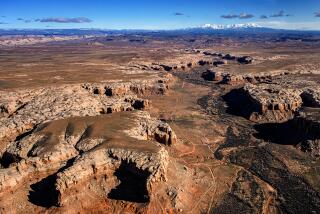Texas Indians Seek to Save Old Ways
- Share via
ALABAMA-COUSHATTA INDIAN RESERVATION, Texas — Marlena Bullock stands before a dressing room mirror braiding her dark hair, a red ceremonial dress hiked up over her jeans. In a few minutes she’ll perform a traditional dance for tourists.
In the swampland of the Big Thicket, Chief Clayton Sylestine, 67, swings a machete to cut river cane. With his walking stick, he stirs the tall grass in front of a long-leafed pine to scare off rattlesnakes, then bends a heavy branch to grab handfuls of needles.
He will take the cane and needles home to weave baskets tight enough to hold water.
“I try to keep the old ways, but it is hard sometimes,” Sylestine says. “There is so much of the modern world we have to deal with.”
The Alabama-Coushatta Indians, already fighting to save their dying language, also hope to preserve their crafts and dances. The tribe’s cultural committee offers classes in the traditional crafts and sells the results in the reservation gift shop.
Preserving the artistic heritage of this tribe of about 1,000 isn’t easy. Many tribal members work in Houston, the nearest city, and drive 180 miles round trip each day. Most are too busy to weave baskets. Sylestine didn’t take up the craft until he retired from driving a logging truck.
This woodland tribe has largely been bypassed by the chic of Native American culture. Alabama-Coushatta crafts don’t have the cachet of Hopi kachina dolls or Navajo jewelry. Despite the baskets’ intricate checkered patterns in black, red and brown, there is little demand for them in the world’s hotel shops.
Even in their own reservation store, Alabama-Coushatta goods are far outnumbered by the moccasins, turquoise jewelry and wolf T-shirts ubiquitous at Indian trading posts on interstates from Tennessee to Arizona.
“The problem is that so much of our own culture has been lost,” says Therese Batisse, who works at the gift shop. “There is so much we don’t know.”
Like other aspects of the Alabama-Coushatta culture, their religion was almost eradicated by waves of Spanish, French and English settlers.
“Most people are Presbyterian now,” Batisse says. “We used to be sun worshipers, but we don’t know much about our religion. There are a few people that secretly kept the old ways, but most of us know nothing.”
Sharon Miller, tribal spokeswoman, says even the dances were mostly lost.
“It was so pounded into our heads by Christianity that what we were doing was wrong and pagan,” Miller says. “Some people went way out into the woods and practiced the dances, and that is the only way they have survived at all.”
When they perform for tourists, the Alabama-Coushatta usually dress in the flashy regalia of other tribes rather than their own more modest dress. And they dance the more dramatic patterns of the Great Plains and the Southwest tribes, different from the subtle, sinuous movements passed down from ancestors.
This does nothing to diminish 22-year-old Marlena Bullock’s pleasure in putting on native dress and performing the dances. She says the dances are a part of her heritage whether they originated with her tribe or another. She is teaching them to her 2-year-old daughter, who often performs with her.
“I started dancing when I learned to walk,” Bullock says. “I’m going to keep dancing. It is who we are.”
*
* LANGUAGES UNDER SIEGE
Tribes’ languages face an uncertain future as speakers dwindle. A20
More to Read
Sign up for The Wild
We’ll help you find the best places to hike, bike and run, as well as the perfect silent spots for meditation and yoga.
You may occasionally receive promotional content from the Los Angeles Times.






